PREFACE
Since our own days as undergrads, we’ve been excited by how the science of social psychology helps us understand everyday life. Our goal in this book is to generate this same kind of excitement for a new generation of students. How? By presenting the best, brightest, and most current ideas and findings the field has to offer in a conceptually coherent and lively narrative. We want students to appreciate that social psychology is, first and foremost, the science of all of us. And so we have aimed to write a book that all students, regardless of their backgrounds, social identities, and career interests, will find enriching and enjoyable.
There’s only one good reason to spend many years bringing a new social psych text into the world: to present the field’s body of knowledge in a more compelling and appealing way than any of the texts that are currently available. We have tried to do this primarily through a lot of hard work, digging into literatures both from within the traditional bounds of the field and from related disciplines, thinking creatively, staying abreast of the latest developments, and discussing and debating what to present and how best to do it. Indeed, every chapter involved a close collaboration among the four of us, resulting in a consistent voice that conveys our collective knowledge, experience, and insight.
Connecting Theory, Research, and Application

These nuts and bolts are very important, but so is the architectural plan, the overarching vision that provides coherent structure both within and across chapters. Our vision is to present social psychology in a more coherent and integrative way than prior texts have done. As teachers of introductory social psychology, we have long been struck by the tendency of textbooks to treat each topic as a distinct form of human behavior—
In our teaching, we find that what sticks with students is rarely a single experiment or definition picked from the field’s vast array of concepts and findings. Instead, students most value learning the broader theories in the field, theories that often have implications for understanding diverse social phenomena. For instance, Kevin, one of our former students who is now in finance, notes that he has benefited from theories in social cognition that explain how people’s habits of thought can bias their judgments and decisions. Anna, now a graduate student, still gains insight from existential theories of the motives behind people’s quest for meaning and self-
xxvii
We believe that theories and research discoveries have their greatest value when they are applied to everyday experiences, important social issues, and contemporary events. We want students to easily see the intimate connections among theory, research, and applications. To accomplish this, we weave together theory; findings; personal, historical, and media examples; and applications throughout the narrative flow of the text. We also created specially designated application sections that translate findings to health, law, politics, social justice, fashion, and a variety of other topics that matter to students’ lives. These applications are seamlessly integrated throughout the text (rather than being covered in separate applied chapters at the end of the text) and are indicated visually with descriptive icons. For convenient reference, the icons also appear next to each application heading in the detailed Table of Contents.
To reinforce further how social psychological knowledge can illuminate the world we all live in, we also highlight in feature boxes how the field’s knowledge can be applied to understand real historical and personal events (Social Psych Out in the World):
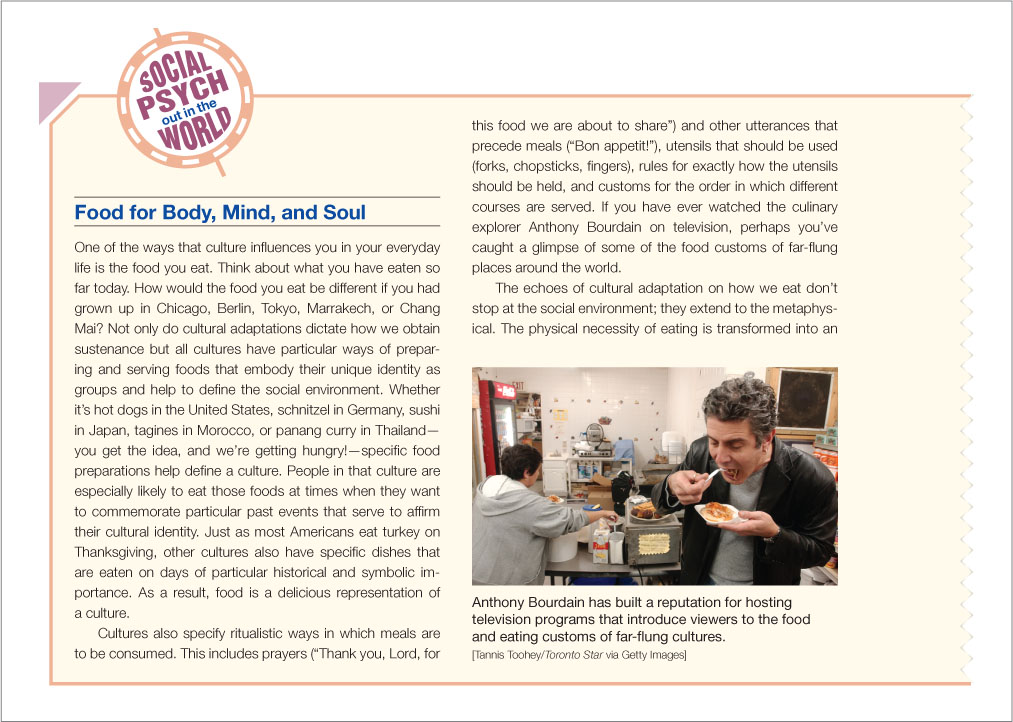
Culture and the arts are mirrors to our inner nature as well as the major issues facing society. So each chapter also includes a feature box that connects theories and findings to human behavior as portrayed on film. These boxes reinforce key concepts by bringing them to life using vivid examples from classic and contemporary films (Social Psych at the Movies):
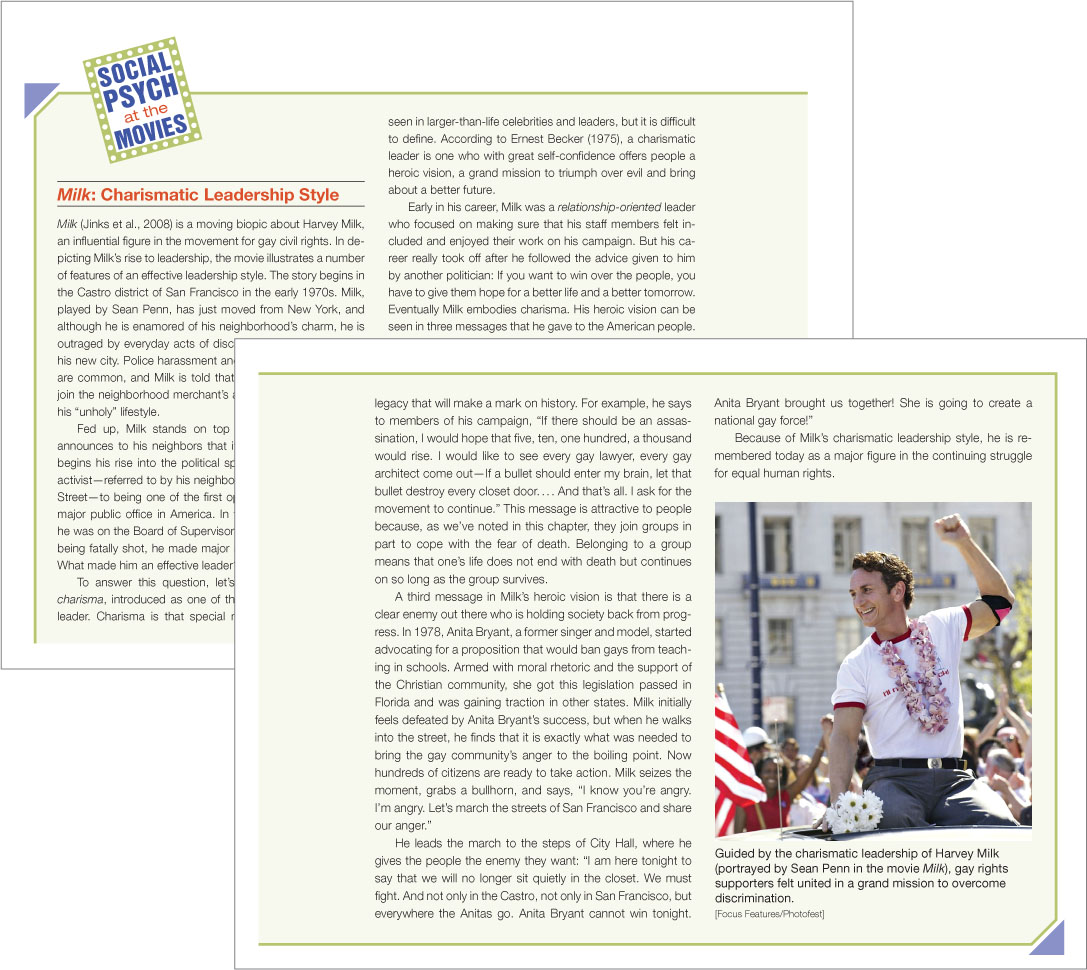
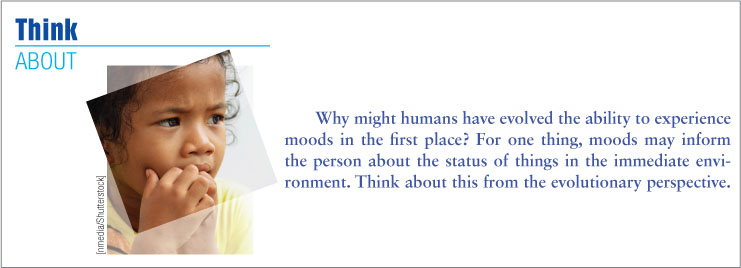
xxviii
To help students relate concepts to their own lives, we engage them in the narrative by asking specific questions throughout the text, often highlighted as Think About features. Here is one such question, in blue type and accompanied by a photo, asked directly to the student.
xxix
Overarching Perspectives
A final aspect of this textbook’s overarching integrative vision is to utilize five broad perspectives that serve as recurring motifs throughout the book: culture, evolution, social cognition, cognitive neuroscience, and existential psychology. These themes provide some sense of continuity both within and across chapters. Of course, social psychology is a diverse field that is not constrained by one single perspective or one small set of perspectives. Instead, the field’s accumulated knowledge has benefited from researchers’ seeking to understand behavior from many different points of view and levels of analysis. We think that’s one of the most exciting aspects of our field. Although each of the five broad perspectives is noted in the context of presenting particular theories and research findings, it was important to us not to use them in a restricting, rigid, or imperialistic way.
Both across and within chapters, there is no one perfect way to organize the vast array of theories and research programs generated by social, personality, cultural, and evolutionary psychologists, as well as researchers in related disciplines. We believe that, whatever the topic and approach to organization, the coverage has to convey the classic and contemporary discoveries that are most revealing in answering important questions. With this goal in mind, we have ensured that our organization of each chapter is not guided in a formulaic way by the five perspectives but by our desire to provide a conceptually coherent, comprehensible, and memorable discussion of the best and most useful theories and findings pertinent to that topic.
Overview of the Text’s Organization
Chapter 1 begins with a brief consideration of the roots and history of social psychology. We then lay out the five perspectives and the core assumptions of the field. The second half of the chapter is devoted to introducing students to the scientific methods used by social psychologists to investigate human behavior, with a focus on the cyclical interplay of theory and research, correlational and experimental methods, and strengths and limitations of theory and methods. We conclude with a consideration of ethics in research.
Chapter 2 considers cultural and evolutionary perspectives in more detail. Our treatment aims to give equal weight to both perspectives, each of which helps set the stage for understanding the fundamental motivations and cognitive architecture that underlies human behavior. Culture profoundly influences human experience. It’s not just something to discuss to explain gender roles or differences in prevalence of the fundamental attribution error. In our view, culture reveals as much about how people are similar as it does about how they are different. Thus, we carefully consider in Chapter 2 how cultures are structured and the psychological functions they serve. Similarly, the evolution of our species didn’t merely produce domain-
Following up on these broad aspects of human behavior, Chapter 3 and Chapter 4 review the important insights that have come from understanding social cognition, including cutting-
xxx
After covering how we view others and the world around us, we focus on the self in Chapter 5 and Chapter 6. These chapters cover the structure and functioning of the self and set the stage for subsequent chapters by illustrating the mutual constitution of self and social reality. The self-
The next three chapter 7, Chapter 8 and Chapter 9, focus on the rich topics of social influence, persuasion, and group processes. Together, these chapters show how individuals’ motives, beliefs, attitudes, and behavior influence, and are themselves influenced by, interactions with other people. But in addition to covering classic theories and research, these chapters describe recent developments, such as social priming and mimicry, regulatory focus, implicit attitudes, and system justification.
Having examined the person’s core needs, desires, cognitive capacities, self-
In contrast to these negative proclivities, the final three chapters focus on the more positive aspects of human experience: prosocial behavior, interpersonal attraction, and close relationships. We choose to end with these topics for three main reasons. First, they cast a hopeful, upbeat light on human behavior. Second, researchers have made great strides in understanding these topics in the last decade. And finally, although all the topics in social psychology are relevant to everyday life, none are more pertinent to students’ own experiences than those concerning the human desire for and experience of community and close relationships.
We have worked long and hard to write a text that truly conveys our field in a coherent, engaging, and up-
|
Jeff: |
jeff@u.arizona.edu |
|
Toni: |
tschmader@psych.ubc.ca |
|
Jamie: |
arndtj@missouri.edu |
|
Mark: |
mjlandau@ku.edu |
Multimedia to Support Teaching and Learning
LaunchPad

Developed with extensive feedback from instructors and students, Worth Publishers’ breakthrough online course space offers:
Prebuilt units for each chapter, curated by experienced educators, with relevant media organized and ready to be assigned or customized to suit your course
One location for all online resources, including an interactive e-
xxxi
Intuitive and useful analytics, with a gradebook that lets you track how students in the class are performing individually and as a whole
A streamlined and intuitive interface that lets you build an entire course in minutes
Videos and activities to enhance the learning process
– The Science of Everyday Life Activities and Experiment provides interactive online activities that offer students insights into research in social psychology and how it applies to everyday life. After reading a short introduction, students participate in trials or answer questions related to an actual social psychology experiment or research study. Students will later see their responses as compared to the original study. A closing short quiz tests what students learned.
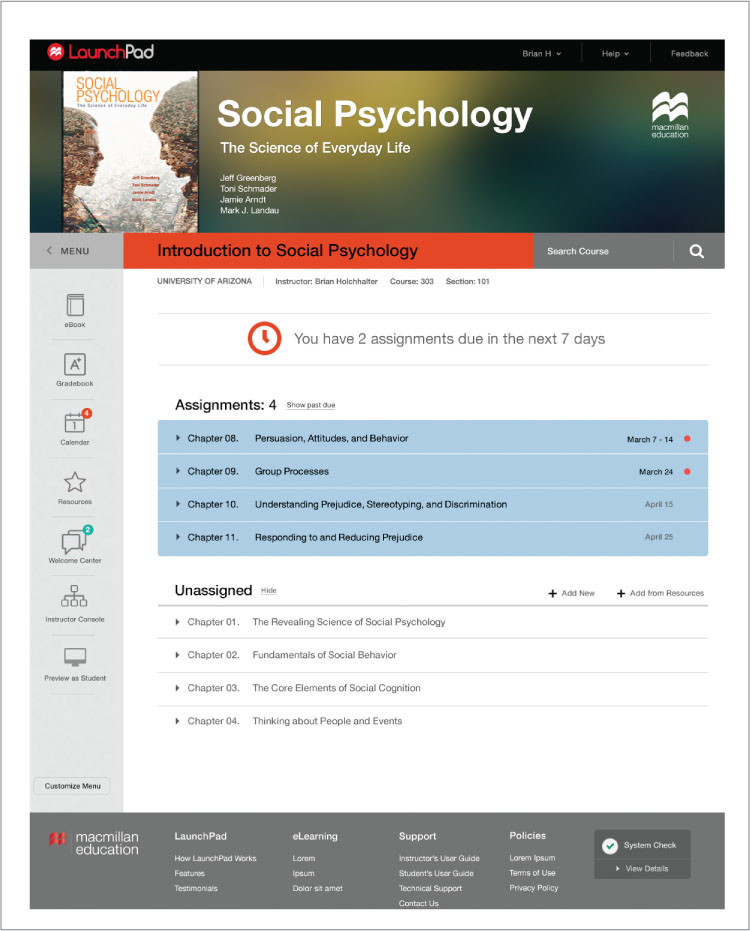
– Student Video Activities include engaging video modules that instructors can assign for student assessment.
xxxii
– PsychSim 6 Activities provide interactive simulations that immerse students in the world of psychological research, placing them in the role of scientist or subject in activities that highlight important concepts, processes, and experimental approaches.
– Online Data Activities help students develop quantitative reasoning skills by asking them to evaluate information and data from published research.
A full suite of instructor resources including Lecture Slides, Illustration Slides, Chapter Figures, Photos, and Tables, Computerized Test Bank, and Instructor’s Resource Manual.
An Instructor’s Resource Manual containing a rich offering of in-
LearningCurve

In a gamelike format, LearningCurve’s adaptive and formative quizzing provides an effective way to get students involved in the coursework. It offers:
A unique learning path for each student, with quizzes shaped by each individual’s correct and incorrect answers.
A Personalized Study Plan, to guide students’ preparation for class and for exams.
Feedback for each question with live links to relevant e-
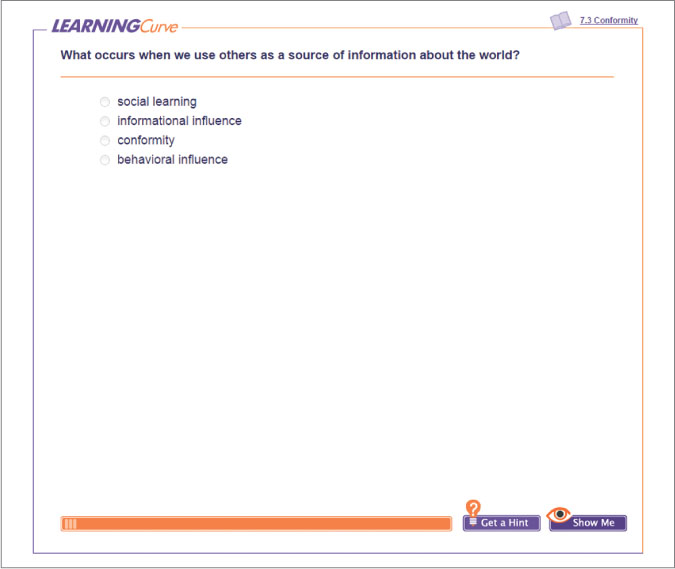
xxxiii
Course Management
Worth Publishers supports multiple Course Management Systems with enhanced cartridges for upload into Blackboard, WebCT, Angel, Desire2Learn, Sakai, and Moodle. Cartridges are provided free on adoption of Social Psychology: The Science of Everyday Life and can be downloaded from Worth’s online catalog at www.worthpublishers.com.
Assessment
The Computerized Test Bank, powered by Diploma, includes a full assortment of test items. Each chapter features over 100 multiple-
xxxiv